Our Lady of the Grasshopper
Our Lady of the Grasshopper
Mary and Animals
Our Lady is frequently associated with the serpent or dragon respectively illustrating Gen.3:15 and Rev. 12:4. She is threatened by the dragon in Revelation, but remains victorious in her fight against evil in Genesis. Most of the animals associated with Mary have a symbolic meaning. The dove points to her virginity and Spirit-centeredness. The unicorn symbolizes Jesus, and rests frequently in Mary’s lap. She gives him love and calms his ardor to punish a thankless world. Beginning in late medieval time, a great number of painters incorporate animals in the representations of Mother and Child. Not only domestic animals like parrots, dogs, and cats are given the honor, but also exotic animals like monkeys and lions. Albrecht Dürer has a pen and ink work of Virgin and Child with a multitude of animals (1503), including stork, stag beetle, butterfly, swan, and dragonfly. A chained fox in the same painting announces the chaining of evil thanks to the Incarnation and the Redemption. In a 1496 engraving of the Holy Family, the same artist adds three bunnies to the bucolic scenery.
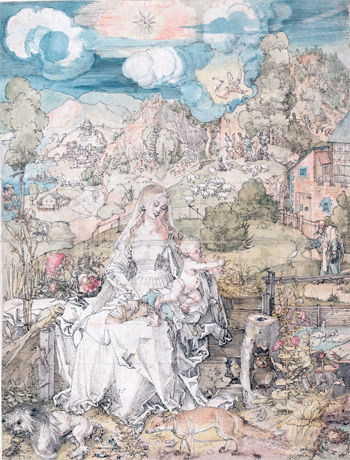 Image shown: Albrecht Dürer, Mary Among a Multitude of Animals
Image shown: Albrecht Dürer, Mary Among a Multitude of Animals
The following reference to grasshoppers has not a symbolic valence but recalls a historical event.
Our Lady of the Grasshoppers
– Very Reverend James S. Goodwin, J.C.L.
In the city of Cold Springs, MN there is a local shrine to the Blessed Virgin Mary. It was originally dedicated to Maria Hilf, but is now formally dedicated to the Assumption of Mary. People call the shrine Grasshopper Chapel. Mary is venerated there as Our Lady of the Grasshoppers.
The shrine was built by Fr. Leo Winter, OSB in 1877. During this era there was a terrible plague of grasshoppers that lasted for several years. The swarms would lay eggs which would then hatch a new plague the next year. This was devastating to the local farmers. The grasshoppers ate everything and covered the ground.[1] Eventually the governor of Minnesota declared April 26, 1877 as a day of prayer asking for God’s deliverance.[2] Fr. Winter asked the parishioners to pray to the Blessed Virgin Mary and suggested that they build a chapel and offer Mass there on Saturdays “to honor the mother of God, to take refuge in her as their intercessor and be freed from the ravages of the grasshopper plague.”[3] The people agreed on July 16, 1877 and the chapel was consecrated on August 15, 1877 the feast of the Assumption. By September 8th, the feast of Mary’s nativity, the grasshoppers were gone.[4]
There is an interesting background story to this incident. The day the chapel was dedicated, the ceremony began at St. John’s Abbey and was described as follows: “one group were led by a wagon carrying the statue of the Virgin, and surrounding the wagon were twelve girls dressed in white and bearing white flags. They were followed by four priests and by twenty-six men on horseback. Along the pilgrimage route the procession passed under a Triumphbogen (triumphal arches), and in Cold Spring, according to the paper’s correspondent, the houses were decorated with flags and trees as if the Blessed Virgin herself or a king had made their way through the village. "Upon the arrival of the pilgrims at the site, the four priests co-operated in the consecration of the chapel, and this ceremony was then followed by a solemn high Mass. The pilgrims from St. Nicholas provided music, and “after mass the crowd scattered and sought to fulfill and satisfy their physical needs at designated tables and bars.” The correspondent was able to report that $340 was raised at the event and that $200 was pure profit. He also asserted that the chapel was to honor the Mother of God, to take refuge in her as their intercessor and be freed from the ravages of the grasshopper plague. Concluding, he noted that the grass-hoppers fled the area only eight days after Father Leo Winter, the young Benedictine who had orchestrated the event, announced his plans to build the chapel.”[5] This did not happen as easily as it appears. There was a replacement of St. Magnus with St. Mary as the primary saint in the local parish.[6] Fr. Winter was a young priest and had great difficulty with his parish. Due to the increasing wealth of the local German immigrant farmers they had become lax in their faith. There was also the issue of trusteeism where they felt that since they paid for the priest he worked for them.[7] As Winter wrote, “After they had gotten together some property, many thought they had it made and had almost forgotten how to pray. They thought themselves independent from God and his commandments. They had the proud impertinence to think that they had money and even paid for the upkeep of the pastor, or as the saying goes, hired him, therefore, the pastor had to do what the farmers wanted. I say this for the eternal memory of future generations. Many of these proud devils learned once more to pray.”[8] He told them that the grasshoppers were a sign of God’s anger and judgment. To avert this they must “turn seriously to the love of God’s Mother and to pledge out of love to build a chapel in her honor … if she would free us from this horrid plague through her mighty intercession with God.”[9] So it would be through a renewal of faith and Marian devotion that God would deliver them from the plague of grasshoppers. Certainly this was a rather Old Testament solution to both problems from the perspective of Fr. Winter. He said that God would “cure” them by trying them with grasshoppers in the wilderness.[10] In addition as Gross writes, “Through the devotion to the Virgin and by her intercessory power the community was restored. It became a family again with the Blessed Mother at its head, and members of the family were reminded of the power of the traditional community to restrain acquisitive and individualistic behavior” and “the pilgrimage involved a profound act of exchange in the form of a sacred compact between the priest, his parishioners, and the Virgin."[11]
The original chapel was destroyed by a tornado on June 20, 1894. It was rebuilt in local granite and dedicated on October 7, 1952. The original wooden statue of Mary holding the infant Jesus, a typical Our Lady of Victory style, stands above the altar.[12] During the summer there is a novena of Masses on Thursday nights and on August 15th there is a procession.[13] These are valued and well attended by local Catholics.
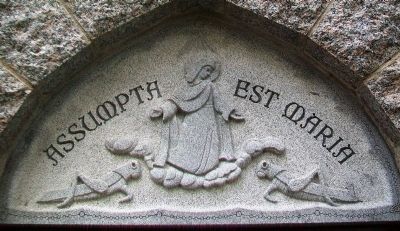
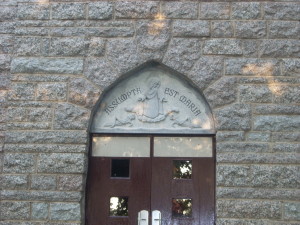
The shrine has some interesting artistic features. The most interesting is the image of Mary on the tympanum above the entrance. There Mary is shown as being assumed into heaven hovering on a bank of clouds. It has the inscription “Assumpta est Maria.” However, this typical image of the Assumption shows her being flanked by two grasshoppers, one on either side, differential in submission to the Virgin. This commemorates her help in ending the plague of grasshoppers and gives the title to the shrine.[14] Inside is the original statue carried in the procession, a German style Our Lady of Victory image in wood. The walls are agate and carnelian donated by the local granite quarries. On the wall is a plaque with the words of the Angelus.[15] There are six stained glass Gothic windows with symbols, titles, and scenes of Our Lady's life. One shows a harp and dove with the words “Et Exultavit Spiritus Meus” or “My Spirit has rejoiced.” Another was the Chi Rho symbol with the words “Ave Maria.” A third window shows Lourdes. The fourth has a stylized vase with MR surmounted by Alpha and Omega and another Chi Rho motif. Another window shows Our Lady of Sorrows. The last one is of the Virgin and Child with Mary as Our Lady of Perpetual Help surmounted by a small Annunciation scene.[16] Outside there is an outdoor altar and the Stations of the Cross situated on beautifully kept grounds. This shrine, with its interesting art work, is a source of pride in the local community for both Catholic, and non-Catholic, alike.
This chapel is a fine and unique example of popular devotion to the Blessed Virgin Mary. I can find no other example of devotion to Our Lady of the Grasshoppers. It arose in the context of German immigration to the upper Midwest. Their faith was challenged by economic prosperity, anti-Catholic and anti-immigrant discrimination, and the destructive threats of nature. Through the determination of a young, but forceful, priest the local Catholics did as they traditionally had done over the centuries back in the Old World. They turned to Mary, imploring her help, and placing themselves under her protection. They remembered her assistance with annual processions and devotions at the shrine. Their descendants kept this memory, rebuilt the shrine, and continue these traditions. Thus their Catholic faith was maintained and enculturated in their new homeland.
Photos:
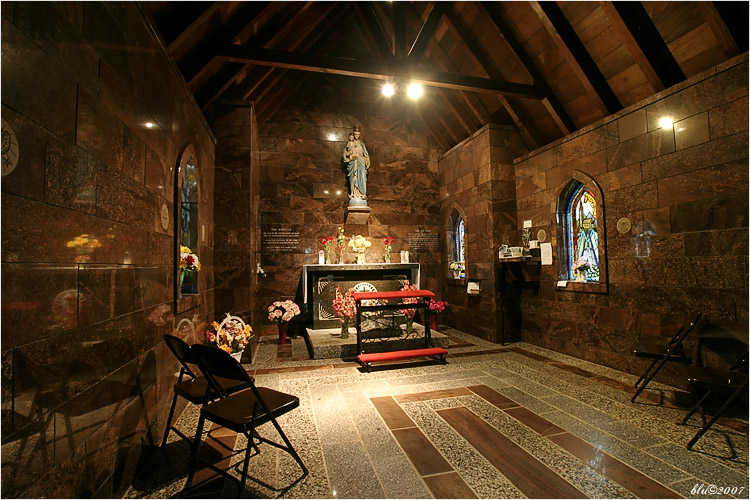
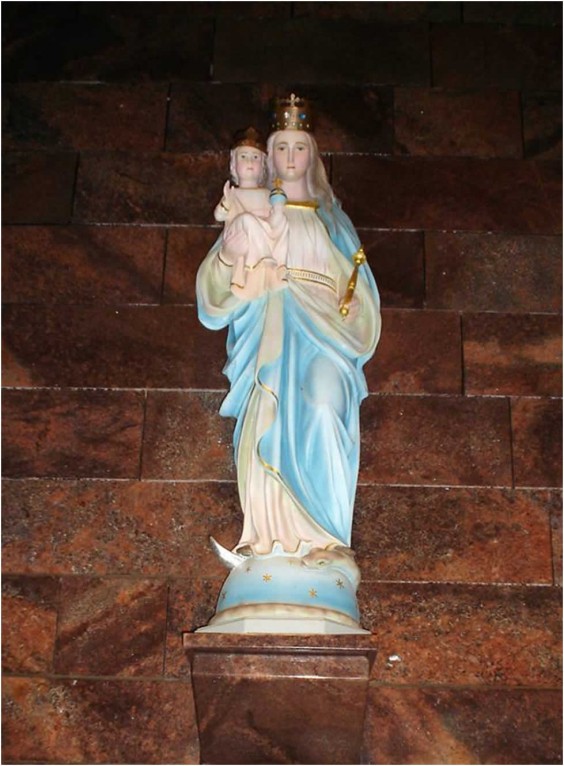
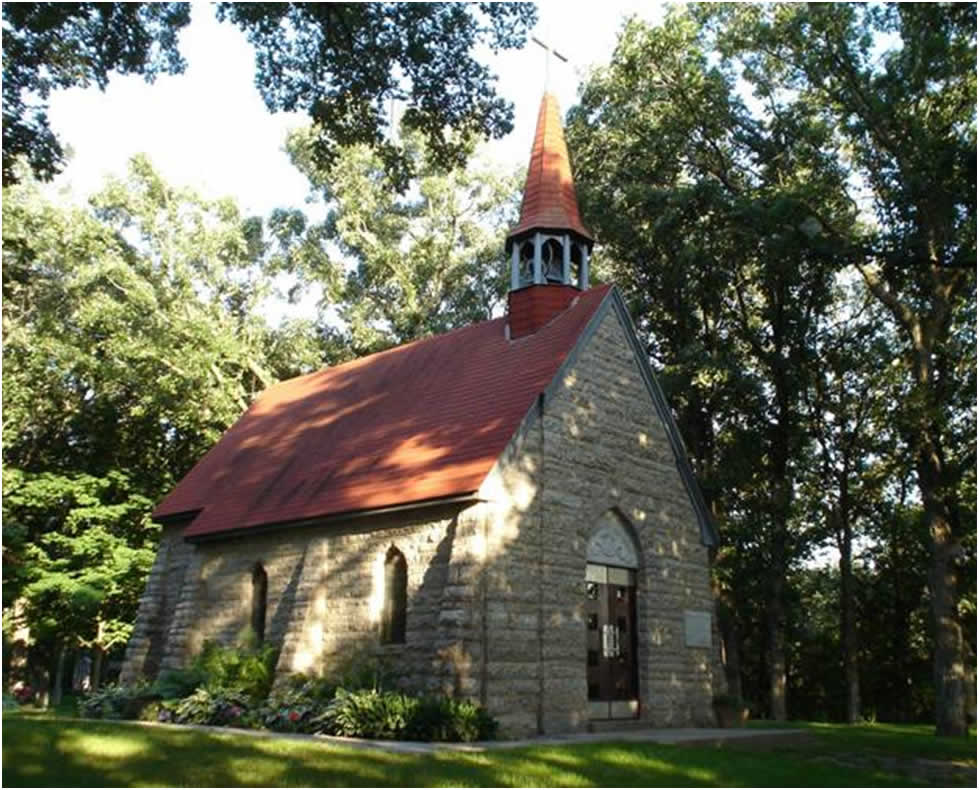
Stained Glass Photos:
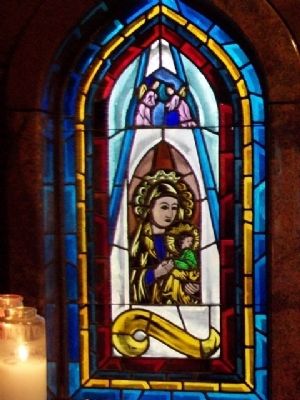
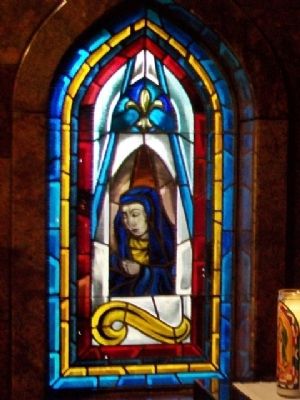
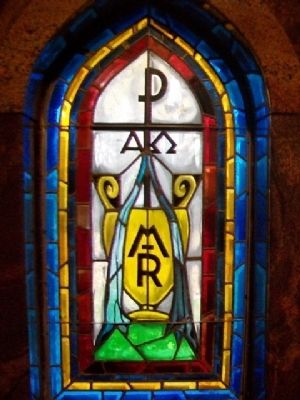
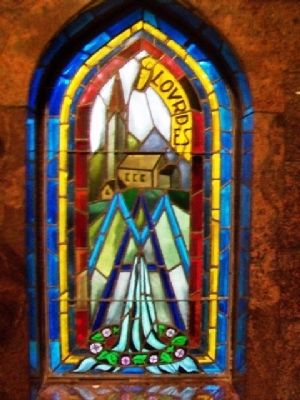
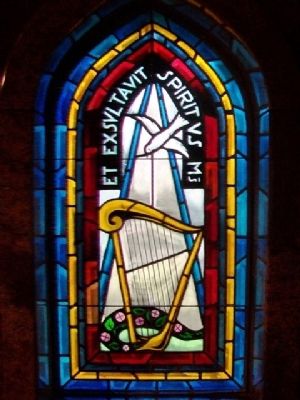
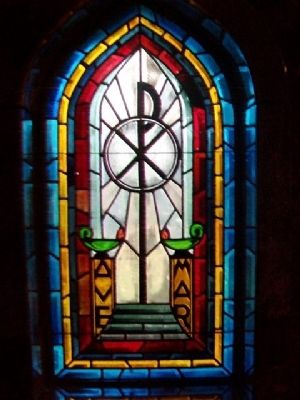
[1] Atkins, Annette (1984). Harvest of Grief. St. Paul, MN: Minnesota Historical Society. http://en.wikipedia.org/wiki/Assumption_Chapel
[2] Voigt, Robert J. (1993). The Story of Mary and the Grasshoppers. Cold Spring, MN. http://en.wikipedia.org/wiki/Assumption_Chapel
[3] Gross, Stephen John (April 2006). "The Grasshopper Shrine at Cold Spring, Minnesota: Religion and Market Capitalism among German-American Catholics". The Catholic Historical Review 92 (2): 215–243
[4] Voight, http://en.wikipedia.org/wiki/Assumption_Chapel
[5] Gross, 217-218.
[6] Ibid, 234.
[7] Ibid, 235-236.
[8] Ibid, 236.
[9] Ibid, 236-237.
[10] Ibid, 237.
[11] Ibid, 239-240.
[12] Ibid, 218.
[13] Ibid, 218-219.
[14] Voight, http://en.wikipedia.org/wiki/Assumption_Chapel
[15] Ibid. http://en.wikipedia.org/wiki/Assumption_Chapel
[16] Photo Credits: William Fischer, Jr. http://www.hmdb.org/marker.asp?marker=78124 and
http://highwayhighlights.com/2013/08/grasshopper-chapel-cold-spring-mn/ and
http://www.abbeyvocations.com/blog/2010/06/three-chapels-devoted-to-the-blessed-virgin-mary/ and
http://www.pbase.com/image/84377120
All About Mary includes a variety of content, much of which reflects the expertise, interpretations and opinions of the individual authors and not necessarily of the Marian Library or the University of Dayton. Please share feedback or suggestions with marianlibrary@udayton.edu.
